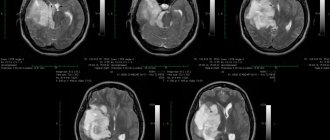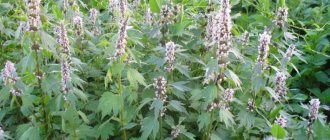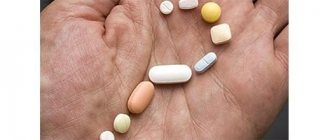Autonomic dysfunction syndrome
April 24, 2021
What it is? This is a complex of symptoms that arise due to a violation of the neuro-humoral regulation of the functioning of organs and systems. Normally, the sympathetic and parasympathetic nervous systems work together harmoniously and smoothly. The sympathetic system prevails if a person needs to act quickly, actively: run, hide, be afraid. Parasympathetic , on the contrary, is when a person is resting, relaxed, sleeping.
When these two systems malfunction, autonomic dysfunction syndrome occurs.
This disorder can be of central or peripheral origin. In the first case, the problem is localized in the structures of the brain. In the second, a malfunction occurs in the structures of the sympathetic and parasympathetic nervous systems.
Primary disorders occur rarely - only in the case of organic damage to brain structures. More often there are secondary disorders in the presence of somatic, mental or neurological diseases.
The course of autonomic dysfunction syndrome can be permanent (constant) or paroxysmal.
People with excess sympathetic innervation have a certain character - they are active, very efficient, energetic people who think quickly, make decisions quickly, and are creative. But at the same time, they often find it difficult to fall asleep, and there is anxiety to a greater or lesser extent.
As a rule, they get used to their personality type, but at certain moments in life, when they take on too much without calculating their strength, or circumstances develop in such a way that they do not have time to recover, their sympathetic system becomes too tense, and then the following arise: complaints:
- sleep is disturbed
- blood pressure increases
- pulse quickens
- there is a feeling of lack of air
- Panic attacks may occur with fear of death or fear of going crazy.
People with a predominance of the parasympathetic nervous system in their constitution are often thoughtful, slow, indecisive, dreamy, and prone to depression . In difficult life situations or when there is excessive load, their parasympathetic nervous system becomes even more active:
- blood pressure decreases, even to the point of fainting
- sweating occurs
- hands and feet are cold
- it becomes difficult to rejoice, apathy develops
- migraines occur.
Individuals with autonomic dysfunction syndrome are usually pleasant, sensitive, and responsive. Among such people there are many poets, writers, artists, journalists, teachers or simply creative people.
The task of a neurologist is to help a patient with autonomic dysfunction syndrome, explain, reassure, examine and prescribe treatment.
First of all, it is necessary to establish the patient’s sleep and wakefulness patterns. It is also necessary to provide him with proper nutrition, to compensate for the lack of vitamins and microelements. It is very important to drink enough water. The TV and computer should be removed from the bedroom, and the sleeping room should be darkened as much as possible. If possible, avoid communication with unpleasant people, maintain information hygiene, that is, reduce the number of irritating factors.
The neurologist must examine the patient to exclude primary damage to the nervous system, prescribe a series of examinations and develop a treatment regimen. In such cases, there is no single template; each patient requires an individual approach and selection of therapy. The treatment uses antioxidants, nootropics, antidepressants, tranquilizers, vitamins, vascular agents, and symptomatic therapy.
Peripheral autonomic failure
Clinical manifestations are multisystem in nature and are not very specific. Failure in the functioning of the sympathetic department of the ANS is manifested by hypohidrosis, diarrhea, ptosis, urinary incontinence, and ejaculation disorders. Weakening of parasympathetic innervation causes constipation, hyperhidrosis, urinary retention, and impotence. Primary peripheral failure occurs with a predominance of orthostatic hypotension, while secondary failure depends on the underlying disease.
Cardiovascular disorders
characterized by orthostatic tachycardia and hypotension, arterial hypertension in a horizontal position. Postural hypotension when standing up is felt by the patient as an attack of lightheadedness, weakness, or a fainting episode. The patient may experience a feeling of “failing,” darkening before the eyes, and noise in the head. In severe cases, the attack ends in fainting lasting about 10 seconds. Orthostatic tachycardia is accompanied by an increase in heart rate by 30 beats/min. with a slight decrease in blood pressure. Patients complain of palpitations, anxiety, sweating, and pain in the cardiac region. In some cases, resting tachycardia is observed (heart rate is fixed at 95-100 beats/min), independent of physical activity.
Respiratory system dysfunction
manifested by short-term episodes of respiratory arrest (including sleep apnea), attacks of suffocation. Severe respiratory distress with blocked cardiovascular reflexes can cause sudden death.
Gastrointestinal disorders
include dyskinesias and atony of the stomach, esophagus, intestines, biliary tract, and gall bladder. Intestinal dysfunction is expressed by periodic constipation or diarrhea. Gastric atony is manifested by a feeling of fullness, anorexia, vomiting, and nausea.
Genitourinary disorders
may be accompanied by polyuria at night, increased frequency of urges, a feeling of incomplete emptying of the bladder, incontinence, difficulty urinating, erectile dysfunction in men, decreased sensitivity of the clitoris in women. Up to 90% of men with primary forms of PVN suffer from impotence.
Visual disorders
. There is a constriction of the pupils, a disorder of their adaptation in the dark. As a result, twilight vision deteriorates.
Dysfunction of the excretory glands
. The functioning of the sweat glands can be disrupted locally, symmetrically, or diffusely. Hypohidrosis is more common. Hyperhidrosis can be nocturnal. A decrease in tear production causes the development of dry eye syndrome, and a disorder of salivation causes dry mouth.
Causes and treatments
According to the latest data, a disorder of the autonomic nervous system can occur against the background of chronic stress, hormonal imbalance, sedentary lifestyle, poor diet, use of tobacco and alcohol products, inflammatory processes and long-term use of medications (including self-medication). One factor is heredity.
The patient’s condition can be corrected using the following non-drug methods:
- Massage and acupuncture. The main goal is relaxation, removing muscle tension and improving blood circulation. Acupuncture has virtually no contraindications and is actively used in the treatment of neuroses and other disorders of the nervous system in adults and children. The beneficial effect of these methods on the patient’s condition has been clinically confirmed, so medical massage in Ufa is one of the most popular procedures.
- Psychotherapy. Often, disorders of the nervous system develop as a result of a person’s mental characteristics. A striking example is workaholism. A person who is completely caught up in work and does not know how to carry out tasks carelessly is in a state of constant stress. Divorce can be no less of a shock (= trigger). Working through your life situation with a psychotherapist allows you to cope not only with the root cause of the disease, but also with its consequences.
You can make an appointment with a cardiologist in Ufa, a neurologist or an orthopedist on our website! Choose a convenient time, leave a comment and wait for our operator to call.
O.V. Vorobyova First Moscow State Medical University named after. I.M. Sechenov, Moscow
The features of the clinical picture of autonomic dysfunction in patients with psychovegetative syndrome, the difficulties of making a diagnosis, and approaches to its treatment are considered. Key words: vegetative dystonia, psychovegetative syndrome, therapy, ethylmethylhydroxypyridine succinate.
Vegetative dystonia – what is hidden by diagnosis? OVVorobiova First Moscow Medical State University named by IMSechenov, Moscow Special features of clinical picture of vegetative dysfunction in patients with psychovegatative syndrome, diagnostic difficulties and approaches to treatment are discussed. Key words: vegetative dystonia, psychovegatative syndrome, therapy, ethylmethylhydroxypyridine succinate.
Information about the authors: Olga Vladimirovna Vorobyova – Doctor of Medical Sciences, Prof. Department of Nervous Diseases, Faculty of Postgraduate Professional Education of Doctors, Perm State Medical University named after. I.M.Sechenova
The autonomic nervous system regulates the basic physiological processes of the body, such as blood pressure, respiratory rate, etc. This system works automatically (autonomously) without personal conscious effort. For a practicing physician, the most common disease of the autonomic nervous system is autonomic dystonia, which refers to psychogenically caused multisystem autonomic disorders. Meanwhile, the term autonomic dystonia is a very broad concept that includes any pathological change in the activity of the autonomic nervous system that occurs when any anatomical structure of the autonomic nervous system (ANS) is damaged. From the standpoint of the anatomical and functional structure of the ANS, autonomic disorders can be divided into three separate clinical syndromes:
• Peripheral (progressive) autonomic failure syndrome (PVF) occurs when autonomic neurons of the lateral horns of the spinal cord, autonomic ganglia, and peripheral autonomic fibers are damaged (autonomic neuropathy). Clinically, PVN is manifested by pathology of the internal organs, the most often observed are: orthostatic hypotension, cardiac rhythm disturbances, gastroparesis, impotence, hypohidrosis and others. PVN develops with degenerative diseases of the nervous system, with hereditary polyneuropathies, with somatic diseases (diabetes, amyloidosis, uremia, systemic diseases, porphyria, alcoholism), etc. • Angio-trophoalgic syndrome occurs mainly with damage to autonomic fibers in the somatic nerves and clinically manifested by local autonomic disorders on the extremities (changes in skin color, swelling, trophic disorders most often in the form of thinning of the skin, atrophy of the subcutaneous tissue, pigmentation and depigmentation of the skin, various pain manifestations). This syndrome develops with various (traumatic, compression and other) lesions of the peripheral nerves or with disorders of the regulation of peripheral vascular tone (connective tissue diseases, hematological diseases, Raynaud's disease, etc.). • Psychovegetative syndrome (PVS) – multisystem autonomic disorders resulting from disruption of the activity of the central nervous system structures (upper parts of the brain stem, hypothalamus, limbic system) under the influence of stress factors. Most often occurs in psychogenic diseases: psycho-physiological reaction to stress, adaptation disorder, psychosomatic diseases, post-traumatic stress disorder, neurotic diseases, but can develop in organic diseases of the nervous system, somatic diseases, physiological hormonal changes, etc.
PVS is a term that more accurately reflects the clinical picture of psychogenic multisystem autonomic disorders than autonomic dystonia syndrome, as it emphasizes the obligatory nature and priority of mental disorders. It is acceptable to use this term when formulating a syndromic diagnosis, at the stage of clarifying the category of psychopathological syndrome associated with autonomic disorders. Features of the clinical picture of autonomic dysfunction in patients with psychovegetative syndrome. Most patients with psychogenically caused autonomic dysfunction present exclusively somatic complaints. Approximately a third of patients, along with massive somatic complaints, actively report symptoms of mental ill-being (feelings of anxiety, depression, irritability, tearfulness). Typically, patients tend to interpret these symptoms as secondary to a “severe” somatic illness (reaction to the disease). Since autonomic dysfunction often imitates organ pathology, it is necessary to conduct a thorough somatic examination of the patient. At the same time, when examining this category of patients, it is advisable to avoid uninformative, numerous studies, since both the ongoing studies and the inevitable instrumental findings can support the patient’s distorted ideas about his disease. Actually, autonomic disorders in this category of patients have multisystem manifestations. However, a particular patient can actively focus the doctor’s attention on the most significant complaints, for example in the cardiovascular system, while ignoring symptoms from other systems. Therefore, a practicing physician needs knowledge of typical symptoms to actively identify autonomic dysfunction in various systems. The most recognizable symptoms are those associated with activation of the sympathetic division of the autonomic nervous system. Autonomic dysfunction is most often observed in the cardiovascular system: tachycardia, extrasystole, chest discomfort, cardialgia, arterial hyper- and hypotension, distal acrocyanosis, heat and cold waves. Disorders in the respiratory system can be represented by individual symptoms (difficulty breathing, “lump” in the throat) or present as a pronounced hyperventilation syndrome. Hyperventilation syndrome includes: various respiratory disorders (feeling of lack of air, shortness of breath, feeling of suffocation, feeling of loss of automatic breathing, feeling of a lump in the throat, dry mouth, aerophagia, etc.) and/or hyperventilation equivalents (inhalations, coughing, yawning); muscular-tonic and motor disorders (painful muscle tension, muscle spasms, convulsive muscular-tonic phenomena); paresthesia (feeling of numbness, tingling, “crawling”, itching, burning) of the extremities and/or nasolabial triangle. Some patients experience phenomena of altered consciousness associated with hyperventilation (lipothymia, a feeling of “emptiness” in the head, dizziness, blurred vision, “fog”, “grid” before the eyes, decreased hearing, tinnitus). Gastrointestinal autonomic disorders are represented by such nonspecific symptoms as nausea, vomiting, belching, flatulence, rumbling, constipation, diarrhea, and abdominal pain. An important diagnostic marker of psychovegetative syndrome is the dependence of the intensity of autonomic dysfunction on the dynamics of the current psychogenic situation. As a rule, the appearance or worsening of the intensity of patient complaints is associated with a conflict situation or a stressful event. It is natural for autonomic dysfunction to replace one symptom with another. “Mobility” of symptoms is one of the most characteristic features of vegetative dystonia. At the same time, the appearance of a new “incomprehensible” symptom for the patient is additional stress for him and can lead to worsening of the disease. Autonomic symptoms are associated with sleep disorders (difficulty falling asleep, light shallow sleep, night awakenings), asthenic symptom complex, irritability in relation to habitual life events, and neuroendocrine disorders. Identification of the characteristic syndromic environment of autonomic complaints helps in diagnosing psychovegetative syndrome. How to make a nosological diagnosis? Mental disorders obligately accompany autonomic dysfunction. However, the type of mental disorder and its severity vary widely among different patients. Most often, autonomic dysfunction is associated with emotional and affective disorders: anxiety, depression, mixed anxiety-depressive disorder, phobias, hysteria, hypochondria. The leader among psychopathological syndromes associated with autonomic dysfunction is anxiety. Autonomic symptoms are nonspecific and are obligately observed with any type of anxiety. Mental symptoms of anxiety, relating to the type of formation and course of anxiety, determine the specific type of anxiety disorder. Because anxiety disorders differ from each other primarily in the factors that cause anxiety and the evolution of symptoms over time, situational factors and the cognitive content of anxiety must be carefully assessed by the clinician. Most often, general practitioners come to the attention of patients suffering from generalized anxiety disorder (GAD), panic disorder (PD), and adjustment disorder. GAD usually occurs before the age of 40 (the most typical onset is between adolescence and the third decade of life), and runs chronically for years with pronounced fluctuations in symptoms. Patients complain of vegetative symptoms (dizziness, tachycardia, epigastric discomfort, dry mouth, sweating, etc.), symptoms of motor tension (motor restlessness, fussiness, inability to relax, tension headaches, chills). When questioning, it is important to find out what the patient's main concern is. The main manifestation of GAD is excessive worry or worry about everyday events. The content of anxious fears usually concerns the topic of one’s own health and the health of loved ones. At the same time, patients strive to establish special rules of behavior for themselves and their families in order to reduce the risks of health problems to a minimum. Any deviations from the usual life pattern cause increased anxiety. Increased attention to one's health gradually forms a hypochondriacal lifestyle. Panic disorder (PD) is an extremely common, chronic disease that manifests itself at a young, socially active age. The main manifestation of PR is repeated paroxysms of anxiety (panic attacks). A panic attack (PA) is an inexplicable, painful attack of fear or anxiety for the patient in combination with various vegetative (somatic) symptoms. The first attacks leave an indelible mark on the patient’s memory, which leads to the appearance of an anxiety syndrome of “anticipation” of an attack, which in turn perpetuates the repetition of attacks. Repeating attacks in similar situations (in transport, being in a crowd, etc.) contributes to the formation of restrictive behavior, i.e. avoiding places and situations that are potentially dangerous for the development of PA. Over time, the periods between attacks become overgrown with various symptoms. The patient begins to constantly be bothered by a feeling of interruptions in the heart, dizziness, instability, nausea or other manifestations of autonomic dysfunction. During this period of illness, some patients find it difficult to isolate panic attacks among the vegetative symptoms that constantly bother them. Only careful, targeted questioning makes it possible to isolate paroxysmal anxiety and its comorbid generalized anxiety or depressive disorder. Some individuals with extremely low stress tolerance may develop a painful condition in response to a stressful event that is not beyond normal or everyday mental stress. Stressful events that are more or less obvious to the patient cause painful symptoms that disrupt the patient’s usual functioning (professional activities and social functions may be disrupted). These painful conditions are called adaptation disorders. Usually the patient himself associates the appearance of painful symptoms with the stressful state he experienced. Sometimes medical findings or suspicion of a serious illness serve as such a stress factor. The clinical manifestations of adaptive disorder are extremely variable. However, it is usually possible to distinguish psychopathological symptoms and associated autonomic disorders. It is vegetative symptoms that force the patient to seek help from a doctor. Most often, maladjustment is characterized by an anxious mood, a feeling of inability to cope with the situation, and even a decrease in the ability to function in everyday life. Anxiety is manifested by a diffuse, extremely unpleasant, often vague feeling of fear of something, a feeling of threat, a feeling of tension, increased irritability, and tearfulness. At the same time, anxiety in this category of patients can manifest itself as specific fears, primarily concerns about their own health. Patients are afraid of the possible development of stroke, heart attack, cancer and other serious diseases. This category of patients is characterized by frequent visits to the doctor, numerous repeated instrumental studies, and a thorough study of the medical literature. Psychovegetative syndrome may be associated with somatic pathology. Anxiety is especially often associated with the following chronic diseases: hypertension, ischemic heart disease, chronic bronchopulmonary diseases, peptic ulcer, epilepsy, stroke, chronic pain syndromes, migraine. The need to differentiate the many somatic symptoms of anxiety from those of a physical illness becomes a significant challenge in some cases. Alarming symptoms can be mistakenly regarded as signs of an underlying disease, which often leads to unnecessary therapy. Anxiety disorder in patients with comorbid somatic disease can manifest itself with various autonomic and mental symptoms that are described in primary pathological anxiety. The clinical manifestation of anxiety symptoms often does not meet the criteria for a delineated anxiety disorder and represents a recurrent group of symptoms with less duration and severity than required for syndromic classification. These subsyndromal anxiety disorders are the most difficult to diagnose. In addition, epidemiological studies show that in patients suffering from chronic somatic diseases, there is a high prevalence of a combination of symptoms of anxiety or anxiety disorders with depression. However, distinguishing between anxiety and depressive symptoms is for the most part very difficult because many symptoms lack specificity. Not only general symptoms, but also some common psychobiological links in pathogenesis allow us to discuss a certain continuum: anxiety-depression. Many medications and other chemical substances can cause anxiety symptoms, including autonomic dysfunction. Excessive caffeine consumption or abrupt cessation of caffeine consumption causes significant anxiety symptoms. Various receptor medications cause the manifestation of anxiety, which is interpreted as a side effect of the drug. The following may cause anxiety: adrenergic agonists, bronchodilators, corticosteroids, drugs that affect thyroid function, antihypertensive drugs, cardiovascular drugs, especially digitalis derivatives. Approaches to the treatment of psychovegetative syndrome. Despite the obligatory nature of autonomic dysfunction and the often masked nature of emotional disorders, the basic method of treating anxiety is psychopharmacological treatment. The range of anti-anxiety drugs is extremely wide: tranquilizers (benzodiazepine and non-benzodiazepine), antihistamines, a2d-ligands (pregabalin), minor antipsychotics, sedative herbal preparations and, finally, antidepressants. Antidepressants have been successfully used to treat paroxysmal anxiety (panic attacks) since the 1960s. But already in the 90s it became clear that, regardless of the type of chronic anxiety, antidepressants effectively relieve anxiety. Currently, selective serotonin reuptake inhibitors (SSRIs) are recognized by most researchers and practitioners as the first choice drugs for the treatment of chronic anxiety disorders. This provision is based on the undoubted anti-anxiety effectiveness and good tolerability of drugs in this group. In addition, with long-term use, SSRIs do not lose their effectiveness. For most people, the side effects of SSRIs are mild, usually appearing during the first week of treatment and then disappearing. Sometimes side effects can be mitigated by adjusting the dose or changing the timing of the medication. Taking the medication regularly results in the best results from SSRIs. Typically, anxiety symptoms begin to subside one or two weeks after starting to take the medication, after which the anti-anxiety effect of the drug increases in a graduated manner. Benzodiazepine tranquilizers are mainly used to relieve acute symptoms of anxiety and should not be used for more than 4 weeks due to the risk of developing a dependence syndrome. The fairly rapid achievement of an anti-anxiety, primarily sedative effect, and the absence of obvious adverse effects on the functional systems of the body justify the well-known expectations of doctors and patients, at least at the beginning of treatment. The combination of SSRIs with BZ or minor antipsychotics is widely used in the treatment of anxiety. Individual vegetative symptoms may be an indication for combination treatment. For example, beta blockers reduce tremor and stop tachycardia, drugs with anticholinergic effects reduce sweating, and minor antipsychotics affect gastrointestinal distress. For short-term subsyndromal or mild anxiety disorders, herbal sedatives or drugs based on them, antihistamines (hydroxyzine) are used. As an additional therapy for psychovegetative syndrome, drugs can be used that potentiate the effects of tranquilizing, neuroleptic, hypnotics, anticonvulsants and analgesics, which allows reducing their doses and reducing side effects. Nootropics and antioxidants, in particular ethylmethylhydroxypyridine succinate, have potentiating effects. Ethylmethylhydroxypyridine succinate is a structural analogue of vitamin B6, acts as an antioxidant, and also, thanks to the succinic acid included in its composition, has antihypoxic properties and improves energy metabolism in the cell. It is important that in addition to the membrane-stabilizing effect of ethylmethylhydroxypyridine, succinate modulates receptor complexes of brain membranes, in particular benzodiazepine, GABAergic, and acetylcholine receptors. It is this effect that is responsible for the anti-stress effect of drugs based on ethylmethylhydroxypyridine succinate. The anti-stress effect is expressed in the normalization of behavior, somato-vegetative indicators, and restoration of sleep-wake cycles. In the complex treatment of psychovegetative syndrome, these drugs can be used if psychotropic therapy is poorly tolerated and to enhance the positive effects of anxiolytics. For subsyndromal anxiety syndromes and mild adaptation disorder, they can be used in monotherapy. Currently, the drug ethylmethylhydroxypyridine succinate, Neurox (Pharm Firm Sotex), is actively used on the Russian market. The recommended course of use of Neurox in patients suffering from psychovegetative syndrome is two to three weeks. In this category of patients, the drug is administered intramuscularly at a dose of 100-400 mg/day, one to three times a day. Based on the range of effects of Neurox, it is most preferable to use Neurox in the initial period of treatment. During the first two to three weeks, co-prescribe an antidepressant or anxiolytic with Neurox, and then continue anxiolytic therapy alone. There are no clear recommendations on the duration of therapy for psychovegetative syndrome. However, most studies have proven the benefits of long courses of therapy. It is believed that after the reduction of all symptoms, at least four weeks of drug remission must pass, after which an attempt is made to discontinue the drug. Stopping the medication too early can lead to an exacerbation of the disease. Residual symptoms (most often symptoms of autonomic dysfunction) indicate incomplete remission and should be considered as a marker of therapy extension and the transition to alternative therapy. On average, treatment is 2-6 months.
Recommended literature 1. Autonomic disorders (clinical diagnosis, treatment) / Edited by A.M. Vein. Medical information agency. M.: 1998; 752. 2. Vorobyova O.V. Psychovegetative syndrome associated with anxiety (issues of diagnosis and therapy). RMJ. 2006; 14: 23 (275): 1696-1699. 3. Vorobyova O.V. Panic attacks (clinic, diagnosis, treatment principles) (brochure). M.: AMA-PRESS LLC, 2009; 46. 4. Vein A.M., Dyukova G.M., Vorobyova O.V., Danilov A.B. Panic attacks. Guide for doctors. Eidos Media. 2004; 403. 5. Barlow D. Anxiety and Its Disorders. Guilford Press, New York London, 2002; 704. 6. Blazer DG, Hughes D, George LK et al. Generalized anxiety disorder. In: Robins LN, Regier DA, eds. Psychiatric Disorders in America: The Epidemiologic Catchment Area Study. New York, NY: The Free Press; 1991: 180-203. 7. Sartorius N., Ustun TB, Lecrubier Y., Wittchen HU Depression comorbid with anxiety: results from the WHO study on psychological disorders in primary health care. Br J Psychiatry. 1996; 168: 38-43.
IDENTIFYING THE PREMIUMINESS OF DEPARTMENTS OF THE AUTONOMIC NERVOUS SYSTEM OF SCHOOLCHILDREN
Published in 2021, Issue No. 04(94) April 2021, MEDICAL SCIENCES | 1 comment
IDENTIFYING THE PREMIUMINESS OF DEPARTMENTS OF THE AUTONOMIC NERVOUS SYSTEM OF SCHOOLCHILDREN
Research Article
Sibiryakova N.V.1, * Ledeneva A.K.2, Tyulegenova A.A.3
1, 2, 3 Astrakhan State Medical University, Astrakhan, Russian Federation
* Corresponding author (galina_262[at]mail.ru)
annotation
The article is devoted to identifying the predominance of parts of the autonomic nervous system among schoolchildren aged 10-13 years. The main method for assessing the ratio of the sympathetic and parasympathetic departments was the method of analyzing heart rate variability. Spectral analysis was used as the main evaluation criterion to identify the predominance of high-, low- and very low-frequency components. Based on the results of the study, it was concluded that the parasympathetic division of the autonomic nervous system predominates, which corresponds to the successful adaptation of schoolchildren to the conditions of an educational institution.
Key words : heart rate variability, schoolchildren, autonomic nervous system, spectral analysis of rhythm.
IDENTIFICATION OF PREVALENCE OF SEGMENTS OF AUTONOMIC NERVOUS SYSTEM AMONG SCHOOLCHILDREN
Research article
Sibiryakova NV1, *, Ledeneva AK2, Tyulegenova AA3
1, 2, 3 Astrakhan State Medical University, Astrakhan, Russia
* Corresponding author (galina_262[at]mail.ru)
Abstract
The article is devoted to the topic of identifying the predominance of the segments of the autonomic nervous system among schoolchildren in the age from 10 to 13 years old. The main method for assessing the ratio of sympathetic and parasympathetic segments is the method of analyzing heart rate variability. Spectral analysis was used as the main evaluation criterion that can reveal the predominance of the high, low, and very low frequency components. Based on the results of the study, it was concluded that the parasympathetic segment of the autonomic nervous system predominates, which corresponds to the successful adaptation of students to the conditions of an educational institution.
Keywords : heart rate variability, schoolchildren, autonomic nervous system, spectral analysis of rhythm.
Relevance
Human life activity and its adaptation to constantly changing conditions of the external and internal environment are associated with the functional activity of the somatic and vegetative systems of the body. [1]. The autonomic nervous system (hereinafter referred to as the ANS) plays a significant role in the body’s adaptation processes. The ANS includes two main sections: sympathetic – responsible for catabolic processes in the body and becomes more important in stressful situations; parasympathetic is responsible for restoring the body’s reserves and anabolic processes [2]. Sections of the ANS, together with the hormones of the endocrine glands, regulate the activity of almost all organs, coordinating their work in order to ensure optimal conditions for the existence of the body at a given time.
The balance of sympathetic and parasympathetic influences inherent in an individual is considered as an individual characteristic and determines to some extent the model of the body’s response to environmental conditions [3].
Analysis of heart rate variability (hereinafter referred to as HRV) is a method for assessing the relationship of activity between parts of the autonomic nervous system. Since the circulatory system is one of the first to respond to the influence of external factors, the tension in the activity of regulatory systems is reflected in heart rate variability. Identification of the predominance of the central or autonomous regulatory circuit clearly demonstrates the state of adaptation mechanisms. Identification of the level of adaptive capabilities is used at the present stage for the purpose of prenosological diagnosis.
The object of our study was school-age children, since during this period of life a child is affected by a complex of various environmental factors, requiring significant expenditure of the body’s reserves. Identification of the predominant type of the autonomic nervous system will allow for prenosological diagnosis of functional and somatic disorders.
Target
To identify the predominance of parts of the autonomic nervous system of school-age children using indicators of heart rate variability.
Materials and principles of research
The study was carried out with the informed consent of the students' parents for a medical examination. 80 children aged 10-13 years were examined. Of these, 15 people are in health group 1, 47 are in health group 2, and 18 are in health group 3. The work used the “Health-Express” hardware and software complex to study the parameters of heart rate variability and indicators of activity of regulatory systems (hereinafter referred to as PARS). The study was conducted before the start of classes in the morning, in a lying position in the school medical center. Moreover, before the start of the study, the children were in a horizontal position for 4-5 minutes. The duration of the heart rate recording was five minutes.
When processing the results, the following indicators were taken into account:
The centralization index is the degree of centralization of heart rhythm control (the predominance of the activity of the central regulatory circuit over the autonomous one).
HF% is the power of the spectrum of the high-frequency component of variability as a percentage of the total power of oscillations. Reflects the activity of the parasympathetic center of the medulla oblongata. The predominance of high-frequency component indicators is observed in healthy people and athletes, in a state of rest and successful adaptation. Decrease – with excessive physical activity, stress, certain diseases of the cardiovascular system (hereinafter referred to as CVS).
LF/HF (vagosympathetic balance coefficient) – the ratio of the power of low frequency waves (LF) to the power of high frequency waves (HF). An increase occurs when the sympathetic division of the autonomic nervous system is activated, and a decrease occurs when the parasympathetic nervous system is activated.
LF% (relative value of low frequency wave power, %) reflects the activity of the cardiac stimulating and vasoconstrictor centers of the medulla oblongata.
VLF% (relative value of the power of very low frequency waves, %) – the level of activity of the sympathetic component of autonomic regulation (mainly suprasegmental sections), demonstrates the activity of humoral-metabolic and ergotropic mechanisms of heart rate regulation. Correlates with anxiety, physical activity, stress.
SI – stress index (regulatory systems tension index) characterizes the degree of tension in regulatory systems.
The method for assessing adaptive reactions is the calculation of PARS. A 10-point scale was used to assess the degree of tension in regulatory systems. Four functional states were diagnosed: physiological norm (1-3 points), moderate tension of regulatory mechanisms (4-5 points), severe tension of regulatory mechanisms (6-7 points), failure of adaptation (8-10).
Main results
In all subjects under conditions of relative functional rest, the indicators of analysis of heart rate variability corresponded to the age norm. The results of the study are reflected in Table 1.
Table 1 – Results of the analysis of heart rate variability in schoolchildren
| Indicators studied | Average values among schoolchildren, M±m | Average values of indicators |
| Centralization index | 2,2±0,28 | 0,67–2,26 |
| HF, % | 42,9±6,1 | 35,79±14,74%. |
| LF, % | 39,2±6,05 | 33,68±9,04% |
| VLF, % | 17,8±4,7 | 28,65±11,24 |
| LF/HF | 1,2±0,13 | 0,7-1,5 |
| SI, % | 69,3±4,7 | 41 – 357 |
Analysis of the obtained values allows us to draw a conclusion about the predominance of the parasympathetic division of the ANS among schoolchildren. This is evidenced by the following results:
- The predominance of the high-frequency component (HF) in 60% of the subjects (48 people);
- According to the LF/HF index, 52.5% (42 people) of students have a predominance of the parasympathetic nervous system;
- SI – 53.8% (43 people) of students are in a harmonious relationship between central regulatory mechanisms and autonomous ones.
- IC – according to data, 67.5% (54 people) of the subjects had a centralization index below the norm. This indicates the predominance of the autonomous regulatory circuit.
There were no significant differences in spectral indicators among children belonging to different health groups (p = 0.3, according to the Wilcoxon test).
The predominance of the autonomous circuit of heart rate regulation indicates optimal conditions for the functioning of the body. The influence of the central regulatory circuit on the heart rhythm is not expressed and the main function of controlling cardiac activity is performed by the autonomous circuit - the parasympathetic division of the peripheral autonomic nervous system.
The PARS assessment confirms the successful adaptation of children to school conditions. The majority of students, 52.5% (44 people), have a state of moderate tension in their regulatory systems, and 31.2% (25 people) have a state of physiological norm. In 11.3 (9 people) there was an active mobilization of protective mechanisms - a pronounced tension in regulatory mechanisms, and only in 2.5% (2 people) - a breakdown of adaptation mechanisms.
conclusions
Among students aged 10-13 years, a predominance of activity of the parasympathetic nervous system was revealed.
The parasympathetic division of the ANS is a system responsible for the ongoing regulation of physiological processes. It is designed to restore and maintain homeostasis, as well as continuously correct changes caused by the influence of the sympathetic department. In addition, the PARS study demonstrates the successful adaptation of most children to the learning environment.
| Conflict of interest Not specified | Conflict of Interest None declared |
List of literature / References
- Mansur T.I. The state of the autonomic nervous system in students during the period of adaptation at university / T.I. Mansur, V.S. Girich, N. Mansur, // Bulletin of RUDN University. Series: Medicine. 2021. 3. p. 41-45.
- Shlyk N.I. Heart rhythm and type of regulation in children, adolescents and athletes. - Izhevsk: Udmurt University Publishing House, 2009. - 259 p.
- Dogadkina S.B. Features of autonomic nervous regulation of heart rate in schoolchildren aged 11-13 years / S.B. Dogadkina // New research. 2 (43). c. 21-26.
- Yamanova G.A. Hygienic assessment of the effectiveness of physical education for schoolchildren / G.A. Yamanova, D.V. Davydenko, A.A. Antonova // In the collection: Science Week - 2021. Materials of the All-Russian Youth Forum with international participation. – Stavropol, 2021. – p. 460-463.
- Yamanova G.A. Physical development of cadets of the Cossack corps / G.A. Yamanova, V.G. Serdyukov, L.A. Milyuchenkova // In the collection: Materials of the XXIII Congress of the Physiological Society named after. I. P. Pavlova with international participation. – Voronezh, 2021. – p. 2287-2288.
- Antonova A.A. Dynamics of anthropometric indicators in schoolchildren aged 11 years / A.A. Antonova, V.G. Serdyukov, G.A. Yamanova // Morphology. 153. 3. P. 22.
- Bezrukikh M.M. Health of schoolchildren, problems, solutions. / M. M. Bezrukikh // Siberian Pedagogical Journal. – 2012. – No. 9. pp.11-16.
- Serdyukov V.G. Social and hygienic features of living conditions as risk factors for children’s health / V.G. Serdyukov, A.A. Antonova, G.A. Yamanova and others // In the collection: Current issues of ensuring the sanitary and epidemiological well-being of the population. Collection of materials from the interregional scientific and practical conference of scientists and specialists of Rospotrebnadzor. – 2021. – p. 71-76.
- Elizarova I.S. Dynamics of the health status of children and adolescents in Astrakhan / I.S. Elizarova, A.A. Antonova, T.V. Serdyukova et al. // Allergology and immunology. – 2012. T. 13. – No. 1. - With. 101.
- Aizman R.I. Problems and tasks of health-preserving activities in the education system at the present stage / R.I. Aizman, E.M. Kazin, A.I. Fedorov // Bulletin of the Novosibirsk State Pedagogical University. – 2014. – No. 1 (17). - With. 9-17.
List of literature in English / References in English
- Mansur TI Sostoyanie vegetativnoy nervnoy sistemy u studentov v period adaptatsii v vuze / TI Mansur, VS Girich, N. Mansur and others // Vestnik RUDN. Seriya: Meditsina. 2021. 3. p. 41-45. .
- Shlyk NI Serdechnyy ritm i tip regulyatsii u detey, podrostkov i sportsmenov. / Shlyk NI // Izhevsk: Izd-vo “Udmurtskiy universitet” – 2009. – 259 p. .
- Dogadkina SB Special vegetativnoy nervnoy regulyatsii serdechnogo ritma u shkol'nikov 11-13 let / SB Dogadkina // Novye issledovaniya. 2015. 2 (43). p. 21-26. .
- Yamanova GA Gigienicheskaya otsenka effektivnosti fizicheskogo vospitaniya shkol'nikov / GA Yamanova, DV Davydenko, AA Antonova // V sbornike: Nedelya nauki – 2021. – Stavropol, 2021. p. 460-463. .
- Yamanova GA Fizicheskoe razvitie kadetov kazach'ikh korpusov / GA Yamanova, VG Serdyukov, LA Milyuchenkova // V sbornike: Materialy XXIII s”ezda Fiziologicheskogo obshchestva im. IP Pavlova s mezhdunarodnym uchastiem. Voronezh, 2021. p. 2287-2288. [in Russian].
- Yamanova GA Vliyanie fizicheskoy nagruzki na sostoyanie oporno-dvigatel'nogo apparata kadetov. // GA Yamanova, VG Serdyukov, AA Antonova and others // V sbornike: Strukturnye preobrazovaniya organov i tkaney v norme i pri vozdeystvii anthropogennykh faktorov. . Sbornik materialov mezhdunarodnoy nauchnoy konferentsii, posvyashchennoy 80-letiyu so dnya rozhdeniya professora Asfandiyarova Rastyama Izmaylovicha. Pod redaktsiey LA Udochkinoy, BT Kurtusunova. Astrakhan, 2021. p. 183-184. .
- Serdyukov VG Sotsial'no-gigienicheskie osobennosti usloviy zhizni, kak faktory riska dlya zdorov'ya detey [Socio-hygienic characteristics of the conditions of life as risk factors for children's health] / VG Serdyukov, AA Antonova, GA Yamanova and others // V sbornike: Aktual'nye voprosy obespecheniya sanitarno-epidemiologicheskogo blagopoluchiya naseleniya Sbornik materialov mezhregional'noy scientific-prakticheskoy konferentsii uchenykh i spetsialistov Rospotrebnadzora. – Astrakhan, 2021 – p. 71-76. [in Russian].
- Chernenkov Yu. V. Monitoring sostoyaniya zdorov'ya shkol'nikov, obuchayushchikhsya v profil'nykh class. Chernenkov [Monitoring of the state of health of the school children trained in profile classes] / Yu. V. Chernenkov A. Yu. Serdyukov, Saratovskiy A. Yu. Scientific-meditsinskiy zhurnal. – 2010. – No. 6 (1). – p. 130-133. .
- Elizarova IS Dinamika sostoyaniya zdorov'ya detey i podrostkov Astrakhani / IS Elizarova, AA Antonova, TV Serdyukova and others // Allergologiya i immunologiya. – 2012. Vol. 13. – No. 1. – p. 101. .
- Ayzman RI Problems and tasks of health-saving activity in the education system at the present stage. / RI Ayzman, EM Kazin, AI Fedorov and others // Vestnik Novosibirskogo gosudarstvennogo pedagogicheskogo universiteta. – 2014. – 1 (17). – p. 9-17. .








